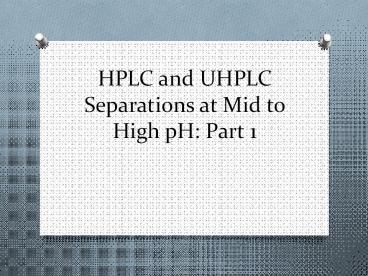HPLC and UHPLC Part 1 PowerPoint PPT Presentation
Title: HPLC and UHPLC Part 1
1
HPLC and UHPLC Separations at Mid to High pH
Part 1
2
Introduction
- Reviewed findings published by Kirkland,
Claessens and co-workers in the 1990s regarding
the factors that can affect the stability,
performance, and lifetime of silica-based RPLC
columns at mid and high pH - Many experts have recommended that reversed-phase
method development begin using low pH mobile
bases
3
Introduction
- Many basic compounds
- carry a full or partial positive charge at low
pH, - will often be poorly retained,
- have poor peak shape, or
- may even be excluded (elute before void) on most
modern type B silica based packings - It is an advantage to be able to use mobile
phases with pHs at or above 7.0 for basic
compounds
4
Advantages of Working at Mid or High pH
- Some analytes are insoluble or insufficiently
soluble at low pH - Some analytes are unstable at low pH
- Some analytes are not adequately retained or
cannot be separated from closely eluting
compounds at low pH - Improvement in response and signal-to-noise ratio
is needed for analysis of basic analytes by LC-MS
vs low pH
5
Advantages of Working at Mid or High pH
- Analytes are not adequately retained or cannot be
separated from closely eluting compounds at low
pH - Can observe improvement in LC-MS response and
signal-to-noise ratio for basic analytes at mid-
or high pH vs. low pH
6
Column Stability
- Degradation of silica-based columns at
intermediate or high pH - largely a function of dissolution of the silica
support - Rather than a loss of bonded phase due to
hydrolysis (cause of column degradation at low pH)
7
Column Stability
- Rate of silica degradation due to dissolution is
affected by - Choice of mobile phase organic modifier
- Type of silica support
- Type and bonding density of bonded phase
- Type and concentration of buffer salts in mobile
phase (NH4, Na, K PO4-3, CO3-2, acetate,
formate, etc.) - Column temperature
- Silica support solubility in the pH 6-8 range is
greatly increased in the presence of phosphate
and carbonate buffers
8
Column Stability
- Silica-based columns are rapidly degraded when
carbonate and phosphate buffers are used at pH 10 - Silica dissolution for untreated silica at pH
9-10 was reduced in high concentrations of
organic modifier
9
Column Stability
- Precolumns of unmodified silica greatly extend
the lifetime of columns used at high pH - Bonded-phase precolumns were much less effective
10
Column Stability
- Longer chain bonded phases are more stable than
shorter chain phases - Certain silica-based, bonded-phase columns can be
used routinely for long periods to at least pH
9-10
http//www.mac-mod.com

